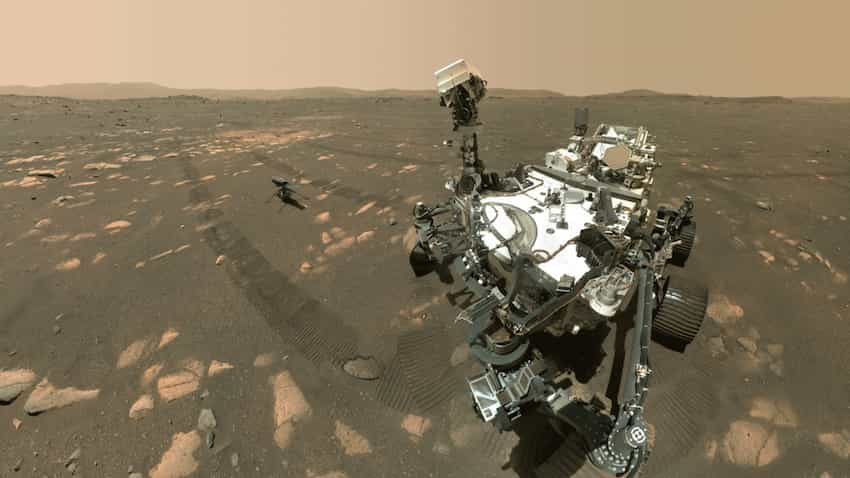2021 was the year of significant scientific breakthroughs. Despite the shortcomings, it proved to be a year of remarkable discoveries.
1. The discovery of the oldest quasar
Quasars are formed when galactic matter spins around a black hole due to its immense gravitational pull. The fast-moving matter that travels toward the center of the black hole heats up to extreme levels due to friction. This in turn emits powerful radiation that can be detected billions of light-years away. And this is what happened with ‘J01313-1806.’

This quasar is located 13 billion light-years from us, and is the furthest and oldest we’ve ever detected. Its radiation needs only 13 billion years to reach us… This is close to the age of our universe, and scientists claim that this quasar was formed just 670 million years after the Big Bang.
2. Entangled photos as means of communication
Researchers at the Nanjing University of Eastern China, have successfully sent entangled photons between drones. Those are utilized as nodes in the creation of mobile quantum networks or flexible network extensions. This is the first time entangled particles have been communicated between two moving machines. Soon enough this could be a game-changer in how communications work.
3. Advanced quantum computers
‘Gooseberry’ is a revolutionary cryogenic computing technology developed by Australian scientists. It enables quantum computers to use thousands of qubits.
Now, you might wonder why this is important if quantum computers already exist. Well, they do exist, but all of them possess a few usable qubits that severely hinder their computing power and scale-up capability. Most quantum computers today manage to handle as much as 100-200 qubits. That’s still not enough to call it a revolution in quantum computing. However, imagine if you scale those computers up to thousands of qubits, and increase their power exponentially.
4. Transparent wood
Researchers revealed in 2021 that they had discovered a technique to make transparent wood that is lighter and stronger than glass. It also uses fewer chemicals and energy compared to previous approaches. The thin wood created by “solar-assisted chemical brushing” is said to be 50 times lighter and stronger than wood treated with other methods. The research was based on a study by a German researcher who converted wood into a translucent material. He did so to show particular cavities of the wood structure for analytical purposes.

5. NASA’s ‘Perseverance’ and ‘Ingenuity’ rovers land on Mars
After seven months of journey, NASA’s ‘Perseverance’ rover and the ‘Ingenuity’ helicopter drone finally arrived at Jezero Crater on Mars. This is not something that hasn’t been done before (‘Curiosity’).
However, ‘Ingenuity’ came to change that by being the first-ever flying rover ever recorded on Mars. This took place on 19 April 2021, and since then 14 more flights were performed. The goal of the robots was to identify ancient Martian environments capable of supporting life. This is done by searching for evidence of previous microbial life, and collecting rock and soil samples on the Martian surface. The last step is to test oxygen production from the atmosphere in preparation for future crewed missions.

6. Dragon Man
In 1933 a skull was discovered in Harbin, China. The skull was nicknamed “Dragon Man” due to its appearance. It wasn’t until 2021, when Chinese scientists discovered that that skull belonged to a different species than humans. This species, weirdly enough, was closely related to the Homo sapiens. They call them the Homo longi, and they date about 146,000 years ago, during the Middle Pleistocene.
7. ‘LaMDA’: Google’s most advanced chatbot
‘LaMDA’ is Google’s latest development in the AI sector. This new type of “chatbot” is open-ended, which means it doesn’t have predefined answers to your questions You can hold a full conversation with it on an almost infinite number of topics. Google believes this will lead to more natural ways of interacting with technology, and open the path for useful applications.
8. Artificial brain
Cerebras has announced a new hardware and software architecture that can handle AI models with 120 trillion parameters. This makes for neural networks that have more synapses than a human brain. This artificial brain, a direct competitor to the human brain, has 850,000 cores and is based on the company’s Wafer Scale Engine Two (WSE-2).
9. 3D printed steak
Researchers have invented a bio-printing approach that uses three types of bovine cell fibers to create steak-like produced meat. The components needed for 3D bio-printing are cells, growth factors, and bio-materials. With these bio-medical components, 3D printing procedures can take place, with the goal of mimicking natural tissue features.
This bio-printing, in general, uses a layer-by-layer procedure to deposit bio-inks to form tissue-like structures that are later employed in medical and tissue engineering fields.

10. Organ regeneration
Regeneration of heart tissue was proven to be feasible in mice in 2021. This was done by switching ‘Yamanaka factors’ proteins for the regeneration of injured hearts without tumor development. This kind of intervention successfully carried out shortly before or after a heart attack. All this is possible with the usage of pluripotent stem cells.
In regenerative medicine, pluripotent stem cells show huge promise. They constitute a single source of cells that might be utilized to replace those lost to damage or illnesses. They can replicate endlessly and give birth to every other cell type in the body (neurons, heart, pancreas, liver cells, etc.).
Did you enjoy our collection?
What other scientific breakthroughs should we add next time?
Please, let us know in the comments, and subscribe & follow us for more.





Comments
Loading…